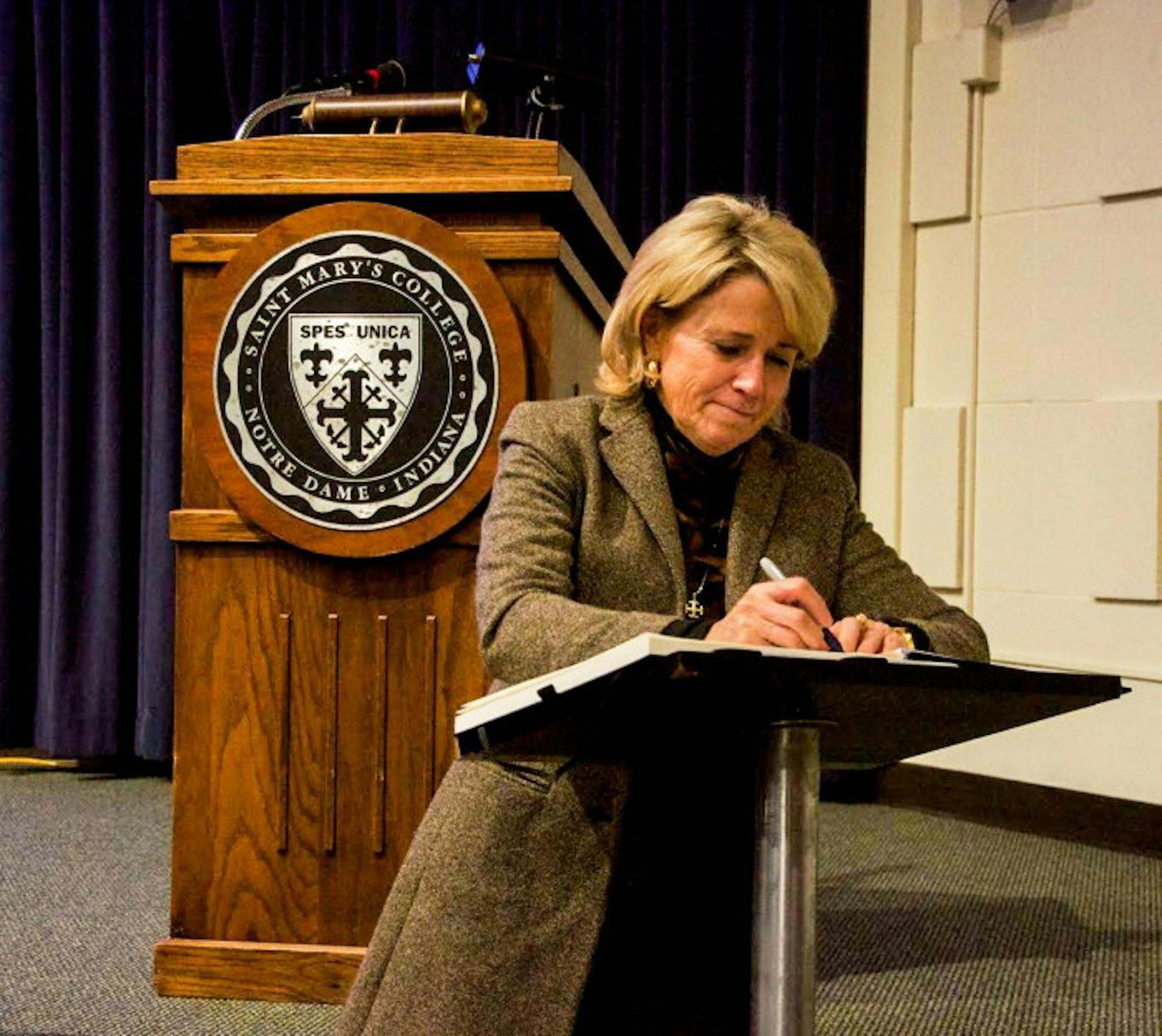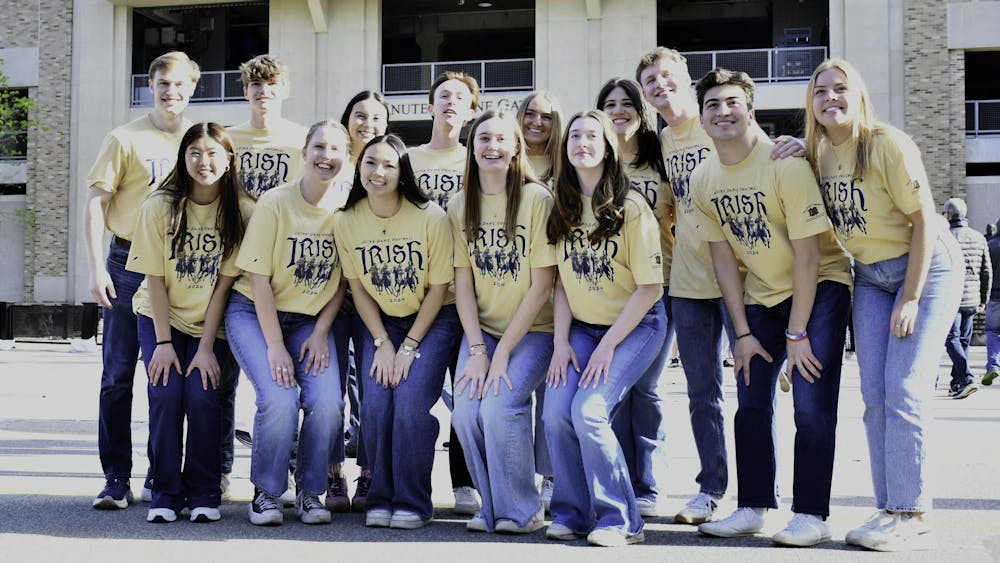College president Jan Cervelli hosted a Town Hall Campus Climate Forum on Monday, during which the results of the Campus Climate Survey on sexual assault — which was administered in January and February of 2016 — were released.
Senior Kayla Gaughan, who served on the Presidential Task Force for Sexual Assault and holds the community justice chair for the Student Government Association, said the It’s On Us campaign was started by President Barack Obama and Vice President Joe Biden to address the epidemic of sexual assault on college campuses.
“The idea inspired all members of the campus community to unite together and create an environment that does not tolerate sexual assault,” Gaughan said. “It is on us to raise awareness, hold ourselves accountable and look out for others who cannot consent.”
Gaughan said the campaign has a group of student leaders who represent seven regions across the United States. She said she challenges the Saint Mary’s community to join the campaign, in hopes that more students will eventually take the pledge than the number of students who have experienced sexual violence.
“My vision for the It’s On Us campaign here at Saint Mary’s is to demonstrate that we do not condone or assume passivity on the issue of sexual assault,” she said. “The Climate [Survey] data released tonight will illustrate the percentage of students who have experienced acts of sexual violence while here at Saint Mary’s.
“I know sexual assault is not easy to talk about, and I know it’s something that most people don’t like to talk about, but when the second most powerful leader in the free world stands up in front of the entire world and says that he believes you, he stands by you and he challenges us to do more, that’s the mark of character and leadership we should all aspire to.”
Cervelli discussed the data gathered by the survey, which is part of a national network called Higher Education Data Sharing Consortium (HEDS). Cervelli said the data gathered at Saint Mary’s was compared with data collected from only females at the participating HEDS institutions.
“This is the first year, first time, we’ve done the survey,” Cervelli said. “It’s a very important instrument that we intend to continue to use. It’s my commitment that Saint Mary’s College is transparent with the information we gather regarding this very important subject, because without transparency, we cannot work together to stop the violence.”
Cervelli said it is important to define what is meant by sexual assault.
“It is ‘which you do not want and which you do not give consent to these various activities,’” she said.
These activities include touching of a sexual nature, oral sex, vaginal sex, anal sex, or anal or vaginal penetration with a body part other than a penis, tongue or by an object.
The location of the sexual assault was also included in the definition of the term and included anywhere on Saint Mary’s campus, an off-campus location that is connected to the College — such as internship or study abroad programs — or social activities or parties at nearby locations — such as apartments, restaurants or bars.
“It’s pretty inclusive relative to where our students go, where they study, work and play,” Cervelli said.
Cervelli said 9.5 percent of students reported being sexually assaulted since coming to college.
“This is a number that I don’t think any of us are happy about,” she said. “One assault is one too many.”
Vice president for student affairs Karen Johnson said that although this number is high, it is lower than what was expected, and lower than women respondents nationally, which is 11.9 percent.
“I was surprised at 9.5 percent,” Johnson said. “I really thought it would be higher. It says two things. One is less people are being assaulted, or less people are reporting and telling us — although the survey was very confidential and very anonymous, so we’re hoping that people were really honest with us. But I was surprised — pleasantly surprised — but surprised, nonetheless.”
Cervelli said eight out of 10 assaults were committed by a student at a different institution, a fact that is peculiar to Saint Mary’s because the majority of assaults reported at other HEDS institutions were on campus, in residential buildings, but by students who also attend that institution.
“I think we can all understand that we’re a women’s institution, and thus, these assaults are not by our own students by and large,” she said. “Assaults on Saint Mary’s students most frequently occur off campus, at either another college, apartment, bar and so on. This is unique to Saint Mary’s.”
According to Cervelli, 93 percent of students reported feeling supported by the faculty.
“I’m very encouraged that you students see that your faculty are here to help you and support you” she said.
Cervelli said she is here to change student perception that the administration is less likely to support students.
According to the study, two-thirds of students who reported a sexual assault were satisfied with how the College responded to their report of sexual assault, while one-third were dissatisfied, Cervelli said.
“This is a good result,” she said. “But that’s not good enough. Two-thirds is not good enough.”
According to Cervelli, a high number of respondents reported having access to information and bystander training.
“I’m very proud of the work of BAVO [the Belles Against Violence Office] and Karen Johnson and student affairs to make students aware of what kind of environments they’re in and when assaults can take place,” she said. “When I say we’re a national leader, this is no exaggeration. We should be proud of our efforts.”
Cervelli said Saint Mary’s, Notre Dame and Holy Cross are working together to prevent violence on all campuses.
“Part of that will have to do with getting more regularity in the formal complaint process, so we don’t have three different processes, and making it more known — not only how to fill out a complaint, but what may be the processes of investigation and regularizing those with our local police forces,” she said. “My dream would be that this would be somewhat of a promise from our institutions to all students coming here that we will, as a tri-campus, be a safe zone, a non-violent zone, that we will be leaders nationally in the practice of prevention and care of victims of violence.”
Johnson said there is no such agreement between three separate universities and colleges in existence currently. According to Johnson, the presidents of the three institutions will sign a legal document that streamlines the process for responding to sexual assault cases among the three schools so students know what to do if assaulted by a student attending any one of them.
“We really feel like we’re breaking ground and being leaders in this area, and we’re really excited about it,” Johnson said.
Johnson said the College is working on implementing more programming to reduce alcohol usage because the survey reported that a higher percentage of sexual assault cases occurred with the presence of alcohol than did not.
“We’ve been trying to do some evening programming, some programming after football games and after basketball games for students who don’t want to delve into the party environment,” she said. “We’re trying all kinds of programming — we just haven’t found the right balance yet.”
Cervelli said that although Saint Mary’s did report a high number of sexual assaults which involved alcohol, alcohol is not to blame.
“It’s important to note that sexual assault happens without any substance at all,” she said. “It’s really important to know that there are predator personalities that — regardless of any substance — they’re targeting individuals. The key is to help individuals not place themselves into situations where they’re vulnerable, whether they’ve been drinking or not.”













